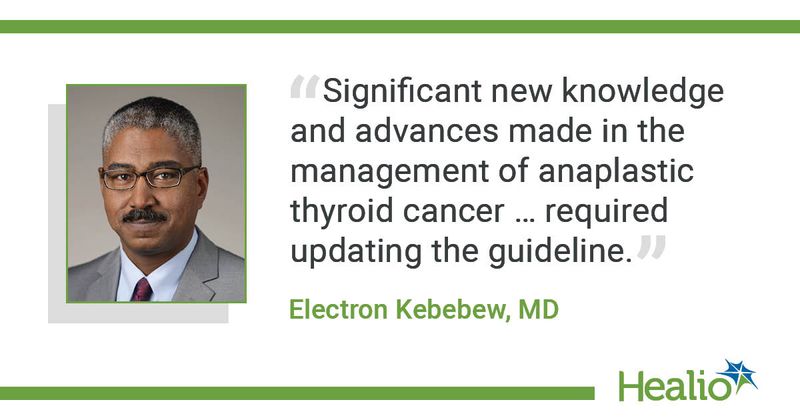Updated guideline highlights new therapies, considerations in anaplastic thyroid cancer
Click Here to Manage Email Alerts
An updated guideline for best practices in managing anaplastic thyroid cancer stresses the need for patient-centered care, considering disease stage and quality of life before attempting aggressive disease management.
Since the American Thyroid Association published the initial guideline for the management of anaplastic thyroid cancer in 2012, substantial clinical and scientific advances have occurred in the field, the authors wrote. As Healio previously reported, the era of untreatable anaplastic thyroid cancer is progressively being replaced by highly specific molecular-based personalized therapy, leading to significant increases in overall survival.

“There has been significant new knowledge and advances made in the management of anaplastic thyroid cancer that required updating the guideline,” Electron Kebebew, MD, chief of the division of general surgery and the Harry A. Oberhelman Jr. and Mark L. Welton professor at Stanford University School of Medicine, told Healio. “The genetic changes that are involved in anaplastic thyroid cancer initiation and progression, refined diagnostic tests and procedures, and individualized and targeted-therapy based on molecular testing of the tumor have improved tremendously to give hope to our patients with anaplastic thyroid cancer; all providers who may see such patients should be aware.”
Anaplastic thyroid cancer is a rare disease, accounting for just 1.6% of all thyroid cancers. It is the most lethal among all thyroid cancers, with a median life expectancy of about 5 months. The sudden onset and aggressive course of anaplastic thyroid cancer requires rapid involvement from a multidisciplinary team to ensure immediate diagnosis, evaluation and treatment, as well as palliative care, the researchers wrote. The guideline includes 31 recommendations and 16 good practice statements.

“Much has changed in the management of anaplastic thyroid cancer since publication of the prior guidelines, including new drug approvals and changing therapeutic options,” co-author Keith C. Bible, MD, PhD, emeritus professor of oncology at Mayo Clinic in Rochester, Minnesota, told Healio. “The new guideline highlights these changes and presents more detailed information, checklists and decision trees to assist in anaplastic thyroid cancer clinical decision-making and management.”
The new guideline considers which patients are the best candidates for aggressive treatment, and focuses on diagnostic and evaluation methods, including imaging and molecular tools. The task force also presents guidelines for surgical resection of anaplastic thyroid cancer tumors, treating metastatic disease, the use of chemotherapy and immunotherapy, and future directions in anaplastic thyroid cancer therapy.
“In the last several years, we have come to better understand how anaplastic thyroid cancer therapies might be individualized on the basis not only of cancer stage, but also based upon tumor-specific mutations,” Bible said in an interview. “This new knowledge has started to positively impact patient outcomes and has even created opportunities for the application of neoadjuvant approaches that did not exist previously.”
The updated ATA guideline, published in Thyroid, is endorsed by the American Association of Endocrine Surgeons, American Head and Neck Society, European Society of Endocrinology, International Association of Endocrine Surgeons, Korean Society of Head and Neck Surgery, Latin American Thyroid Society and the Society of Nuclear Medicine and Molecular Imaging.
For more information:
Keith C. Bible, MD, PhD, can be reached at keithcbible@gmail.com.
Electron Kebebew, MD, can be reached at kebebew@stanford.edu.

